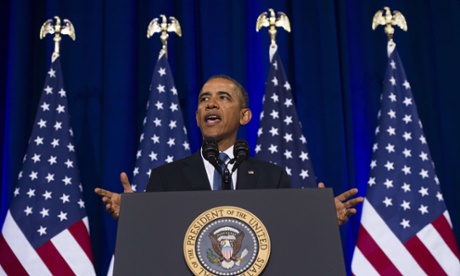Obama aims to suggest cuts to Power-Plant Emissions

President Barack Obama will propose cutting greenhouse-gas emissions from the nation’s power plants by an average of 30 percent from 2005 levels, a key part of his plan to fight climate change that also carries political risks.
The proposal is scheduled to be unveiled by the U.S. Environmental Protection Agency this morning in Washington. It represents one of the boldest steps the U.S. has taken to fight global warming, and drew immediate pledges from Republicans to seek to block the rule.
Obama signaled both the importance of the initiative to his legacy on environmental protection and the bruising fight ahead by joining a conference call yesterday with congressional Democrats, EPA Administrator Gina McCarthy and White House counselor John Podesta to rally support.
Obama dismissed complaints that the rule will hurt the economy by driving up electricity prices, and told the Democrats listening: “Please go on offense” to promote the measure, said two people listening in on the call, including Representative Gerry Connolly, a Virginia Democrat.
The proposal will list a range of options being considered, and note that the administration prefers an average 30 percent cut over 2005 levels by 2030, according to people familiar with the plan. Because emissions from power plants fell about 15 percent from 2005 to last year, the preferred reduction equates to less than a 20 percent from current levels.
By comparison, the Sierra Club was seeking a cut of 25 percent from current levels by 2020, an entire decade earlier.
Consumer Costs
McCarthy told lawmakers on the call that the rule will only lead to minimal cost increases for consumers in some areas and families could end up saving money due to efficiency gains, one participant on the call said. She also stressed that states will be able to design their own approaches to meet the targets, the source said.
Republicans in Congress criticized the plan.
“The White House scheme will raise costs and destroy American jobs,” said Michael Steel, spokesman for House Speaker John Boehner, an Ohio Republican.
Obama refuted that on the call, telling the lawmakers that the new rule limiting carbon pollution will boost the economy by an estimated $43 billion to $74 billion.
The proposed regulation will permit states to achieve the reductions in climate-warming pollutants by promoting renewable energy, encouraging greater use of natural gas, embracing energy efficiency technologies or joining carbon trading markets. The regulations will apply to existing power producers. Separate regulations governing new plants have already been proposed.
Options Listed
The 30 percent reduction represents an average. Individual states may be directed to cut carbon emissions at levels that are greater or less than that overall figure. Because the rule will list options, it will invite both environmental and industry advocates to seek steeper or less onerous reductions over the coming year, when a final version will be issued.
Emissions from power plants were already down 15 percent from 2005 through 2012, halfway to the goal, according to Vicki Arroyo, executive director of the Georgetown Climate Center. The group compiled a list of reductions by state, which showed that many states, including New York, Washington, Virginia and Georgia, have already exceeded cuts of 30 percent.
The plan will also give Obama evidence of America leading by example as he tries to persuade other nations to cut their carbon emissions. Obama pledged five years ago as part of international climate talks that the U.S. would cut its greenhouse gas emissions by 17 percent from 2005 levels by 2020.
Climate Talks
“The decision by President Obama to launch plans to more tightly regulate emissions from power plants will send a good signal to nations everywhere that one of the world’s biggest emitters is taking the future of the planet and its people seriously,” Christiana Figueres, the United Nations’ top climate official, said in a statement today.
Legislation to require economy-wide cuts to emissions through a cap-and-trade system died in the Senate in 2010 under mounting opposition from Republicans and some industrial state Democrats who worried it would raise the costs of electricity. The proposal today is less sweeping, though still historic. Power plants are the source for about 40 percent of the total U.S. carbon emissions, which most scientists say are contributing to rising global temperatures.
Coal’s Role
Plants that burn coal to generate electricity account for about 75 percent of all power-plant emissions. Coal, the most carbon-intensive fossil fuel, provides about 40 percent of the U.S. power. While that’s down from about half, coal is remains the single largest source of electricity generation in the U.S.
The proposed rules are among policies “designed to drive out low-cost electricity and replace it with higher-cost, more expensive and less reliable electricity,” Hal Quinn, chief executive officer of the National Mining Association, said yesterday on ABC’s “This Week” program.
The EPA is counting on coal plants being operated more efficiently and states shifting to natural gas from coal to get modest cuts in the next four or five years, people familiar with it said. Each state will have a target based on its emissions, and in the next decade the overall electric grid will need to become more efficient and use renewable generation to achieve the reductions, they said.
“President Obama is right to take decisive action to combat this clear and present danger,” Frances Beinecke, president of the Natural Resources Defense Council, said by e-mail. “The proposed standards will limit — for the first time in U.S. history — the unrestricted pollution of our atmosphere by carbon dioxide.”
Legal Challenges
Some industry observers have said the approach favored by the administration will leave the rule open to legal challenges under the Clean Air Act because it relies on an interpretation of the law that counts emissions reductions that occur outside power plants — through such things as efficiency measures, greater use of renewable energy and even joining carbon-trading programs. Past regulations have sought to cut pollutants as measured at the smokestack.
Republicans have signaled they intend to make the rule an issue in the House and in campaigns in states where the coal industry is a major employer. Some Democrats have voiced opposition to a plan they worry will hurt them with voters.
“I will continue to fight back by introducing legislation next week on behalf of our coal miners and Kentucky families to stop Obama from imposing this national energy tax — a failed tax which has already been rejected by Congress,” Senate Minority Leader Mitch McConnell, a Republican, said in an e-mail. He said he would soon introduce legislation in the Senate to block the rules from taking effect.
Source: bloomberg





























